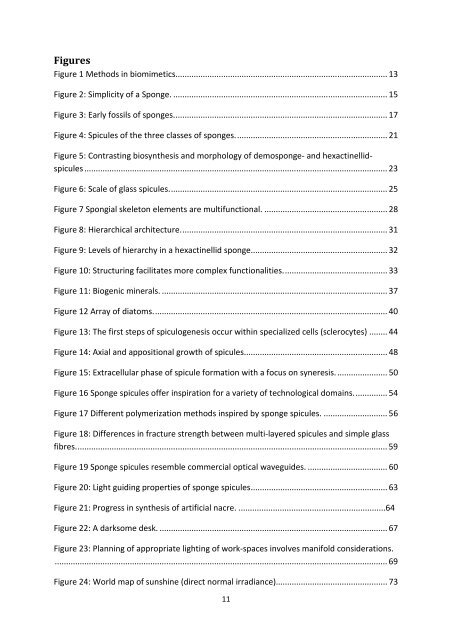MASTER THESIS Biomimetic potential of sponge ... - IAP/TU Wien
MASTER THESIS Biomimetic potential of sponge ... - IAP/TU Wien
MASTER THESIS Biomimetic potential of sponge ... - IAP/TU Wien
You also want an ePaper? Increase the reach of your titles
YUMPU automatically turns print PDFs into web optimized ePapers that Google loves.
Figures<br />
Figure 1 Methods in biomimetics............................................................................................. 13<br />
Figure 2: Simplicity <strong>of</strong> a Sponge. .............................................................................................. 15<br />
Figure 3: Early fossils <strong>of</strong> <strong>sponge</strong>s. ............................................................................................. 17<br />
Figure 4: Spicules <strong>of</strong> the three classes <strong>of</strong> <strong>sponge</strong>s. .................................................................. 21<br />
Figure 5: Contrasting biosynthesis and morphology <strong>of</strong> demo<strong>sponge</strong>- and hexactinellidspicules<br />
..................................................................................................................................... 23<br />
Figure 6: Scale <strong>of</strong> glass spicules. ............................................................................................... 25<br />
Figure 7 Spongial skeleton elements are multifunctional. ...................................................... 28<br />
Figure 8: Hierarchical architecture. .......................................................................................... 31<br />
Figure 9: Levels <strong>of</strong> hierarchy in a hexactinellid <strong>sponge</strong>............................................................ 32<br />
Figure 10: Structuring facilitates more complex functionalities. ............................................. 33<br />
Figure 11: Biogenic minerals. ................................................................................................... 37<br />
Figure 12 Array <strong>of</strong> diatoms. ...................................................................................................... 40<br />
Figure 13: The first steps <strong>of</strong> spiculogenesis occur within specialized cells (sclerocytes) ........ 44<br />
Figure 14: Axial and appositional growth <strong>of</strong> spicules............................................................... 48<br />
Figure 15: Extracellular phase <strong>of</strong> spicule formation with a focus on syneresis. ...................... 50<br />
Figure 16 Sponge spicules <strong>of</strong>fer inspiration for a variety <strong>of</strong> technological domains. .............. 54<br />
Figure 17 Different polymerization methods inspired by <strong>sponge</strong> spicules. ............................ 56<br />
Figure 18: Differences in fracture strength between multi-layered spicules and simple glass<br />
fibres. ........................................................................................................................................ 59<br />
Figure 19 Sponge spicules resemble commercial optical waveguides. ................................... 60<br />
Figure 20: Light guiding properties <strong>of</strong> <strong>sponge</strong> spicules ............................................................ 63<br />
Figure 21: Progress in synthesis <strong>of</strong> artificial nacre. ................................................................64<br />
Figure 22: A darksome desk. .................................................................................................... 67<br />
Figure 23: Planning <strong>of</strong> appropriate lighting <strong>of</strong> work-spaces involves manifold considerations.<br />
.................................................................................................................................................. 69<br />
Figure 24: World map <strong>of</strong> sunshine (direct normal irradiance)................................................. 73<br />
11

















